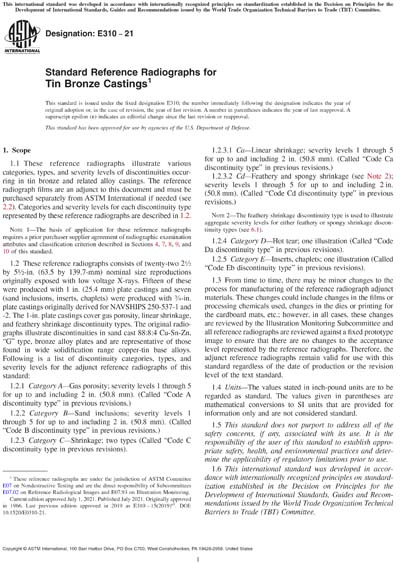Most recent
ASTM E310-21
Standard Reference Radiographs for Tin Bronze Castings
1.1These reference radiographs illustrate various categories, types, and severity levels of discontinuities occurring in tin bronze and related alloy castings. The reference radiograph films are an adjunct to this document and must be purchased separately from ASTM International if needed (see 2.2). Categories and severity levels for each discontinuity type represented by these reference radiographs are described in 1.2.
Note 1:The basis of application for these reference radiographs requires a prior purchaser supplier agreement of radiographic examination attributes and classification criterion described in Sections 4, 7, 8, 9, and 10 of this standard.
1.2These reference radiographs consists of twenty-two 21/2by 51/2-in. (63.5 by 139.7-mm) nominal size reproductions originally exposed with low voltage X-rays. Fifteen of these were produced with 1 in. (25.4 mm) plate castings and seven (sand inclusions, inserts, chaplets) were produced with 3/4-in. plate castings originally derived for NAVSHIPS 250-537-1 and -2. The 1-in. plate castings cover gas porosity, linear shrinkage, and feathery shrinkage discontinuity types. The original radiographs illustrate discontinuities in sand cast 88:8:4 Cu-Sn-Zn, "G" type, bronze alloy plates and are representative of those found in wide solidification range copper-tin base alloys. Following is a list of discontinuity categories, types, and severity levels for the adjunct reference radiographs of this standard:
1.2.1Category A - Gas porosity; severity levels 1 through 5 for up to and including 2 in. (50.8 mm). (Called "Code A discontinuity type" in previous revisions.)
1.2.2Category B - Sand inclusions; severity levels 1 through 5 for up to and including 2 in. (50.8 mm). (Called "Code B discontinuity type" in previous revisions.)
1.2.3Category C - Shrinkage; two types (Called "Code C discontinuity type in previous revisions).
1.2.3.1Ca - Linear shrinkage; severity levels 1 through 5 for up to and including 2 in. (50.8 mm). (Called "Code Ca discontinuity type" in previous revisions.)
1.2.3.2Cd - Feathery and spongy shrinkage (see Note 2); severity levels 1 through 5 for up to and including 2 in. (50.8 mm). (Called "Code Cd discontinuity type" in previous revisions.)
Note 2:The feathery shrinkage discontinuity type is used to illustrate aggregate severity levels for either feathery or spongy shrinkage discontinuity types (see 6.1).
1.2.4Category D - Hot tear; one illustration (Called "Code Da discontinuity type" in previous revisions).
1.2.5Category E - Inserts, chaplets; one illustration (Called "Code Eb discontinuity type" in previous revisions).
1.3From time to time, there may be minor changes to the process for manufacturing of the reference radiograph adjunct materials. These changes could include changes in the films or processing chemicals used, changes in the dies or printing for the cardboard mats, etc.; however, in all cases, these changes are reviewed by the Illustration Monitoring Subcommittee and all reference radiographs are reviewed against a fixed prototype image to ensure that there are no changes to the acceptance level represented by the reference radiographs. Therefore, the adjunct reference radiographs remain valid for use with this standard regardless of the date of production or the revision level of the text standard.
1.4Units - The values stated in inch-pound units are to be regarded as standard. The values given in parentheses are mathematical conversions to SI units that are provided for information only and are not considered standard.
1.5This standard does not purport to address all of the safety concerns, if any, associated with its use. It is the responsibility of the user of this standard to establish appropriate safety, health, and environmental practices and determine the applicability of regulatory limitations prior to use.
1.6This international standard was developed in accordance with internationally recognized principles on standardization established in the Decision on Principles for the Development of International Standards, Guides and Recommendations issued by the World Trade Organization Technical Barriers to Trade (TBT) Committee.
Content Provider
ASTM International [astm]






